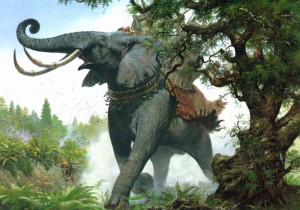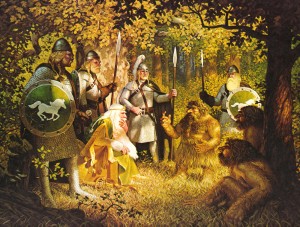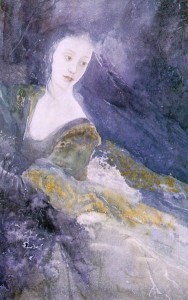The key players in The Lord of the Rings are probably some of the most-written about characters in literature. Everyone loves the leading lights such as Frodo, Aragorn, Sam and Gandalf.
Yet there are a number of minor (some even without a name!) characters who either serve an important purpose, give us a great deal of food for thought, or even go against established yet hard-to-overcome stereotypes about the content of Tolkien’s writing.
In no particular order, here are my leading six.
1) Sam’s dead Southron warrior.

“…suddenly straight over the rim of their sheltering bank, a man fell, crashing through the slender trees, nearly on top of them. He came to rest in the fern a few feet away, face downward, green arrow-feathers sticking from his neck below a golden collar. His scarlet robes were tattered, his corslet of overlapping brazen plates was rent and hewn, his black plaits of hair braided with gold were drenched with blood. His brown hand still clutched the hilt of a broken sword.”
Of Herbs and Stewed Rabbit, The Lord of the Rings.
A common criticism of Tolkien is that evil is evil and good is good and ne’er the twain shall meet. The bad guys only exist to be Othered… and then gloriously hacked to death. Yet Sam’s thoughts on the dead Southron are a direct repudiation of this view.
Sam wonders at the man’s name, where he came from. The questions run thick and fast. Was he was really a bad man? Was he deceived into serving Sauron to march far from his home to die fruitlessly in the woods of Ithilien? Would he really rather have stayed there in peace?
The narrator gives no answers, but the questions in themselves are a powerful reminder that conflict cannot be easily reduced to “us” and “enemy”.
“It was Sam’s first view of a battle of Men against Men, and he did not like it much.”
Considering Sam, of all the hobbits, is our perspective character — the “Everyman” — it’s more important than you might think. Pippin has similarly uneasy thoughts as he watches Saruman’s forces march away south to Helm’s Deep from Isengard.
2) Ghân-buri-Ghân

“There sat Théoden and Éomer, and before them on the ground sat a strange squat shape of a man, gnarled as an old stone, and the hairs of his scanty beard straggled on his lumpy chin like dry moss. He was short-legged and fat-armed, thick and stumpy, and clad only with grass about his waist.”
The Ride of the Rohirrim, The Lord of the Rings.
Another misunderstood criticism: evil is always ugly, and those on the side of good are strikingly handsome. Enter the Woses of Drúadan Forest. The descendents of the solitary and tribal Drúedain folk who fought in the First Age against Morgoth, and abandoned Numenor long before its destruction, there’s nothing pretty about the Wild Men of the Woods. Yet, they assist the Rohirrim to reach the Pelennor in time to save the folk of Gondor.
Of course there are other examples. Most prominently, Sauron assumed a fair form to deceive the elves of Eregion and start the chain of events that leads to the forging of the One Ring.
Icing on the cake, the Woses use poison arrows, and the Marshal of the Mark Elfhelm seems to imply that they’ve even been used on the Rohirrim. If the good folks never resort to foul means to win, the Woses don’t seem to have got the message.
3) Lúthien Tinúviel

“Tinúviel rescued Beren from the dungeons of Sauron, and together they passed through great dangers, and cast down even the Great Enemy from his throne, and took from his iron crown one of the three Silmarils, brightest of all jewels, to be the bride-price of Lúthien to Thingol her father.”
A Knife in the Dark, The Lord of the Rings.
Lúthien doesn’t even directly enter the events of The Lord of the Rings, yet her influence is felt throughout the tale.
Her example, and that of Beren, inspires Frodo to resist the commands of the Nazgúl at the Ford of Bruinen. Her arts of healing — more than once she saved Beren from death’s door — are in a smaller measure seen in her descendents Elrond and Aragorn. And as Sam observes just before he and Frodo enter Torech Ungol, the light of the Silmaril she helps Beren recapture is in the Phial of Galadriel that later proves so vital in keeping hope alive for the Quest.
And make no mistake, Beren could not have wrested the Silmaril from Morgoth alone. Lúthien plays an equal part — probably the key role in my opinion — in the success of that particular quest.


